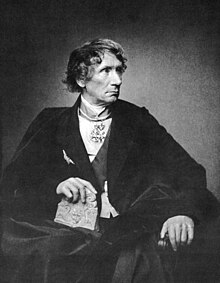Leo von Klenze
Leo von Klenze | |
|---|---|
 | |
| Born | Franz Karl Leopold von Klenze 29 February 1784 Schladen, Germany |
| Died | 26 January 1864 (aged 79) Munich, Germany |
| Resting place | Alter Südfriedhof, Munich, Germany |
| Occupations |
|


Leo von Klenze (born Franz Karl Leopold von Klenze; 29 February 1784 – 26 January 1864) was a German architect and painter. He was the court architect of Ludwig I of Bavaria.
Von Klenze was a devotee of
Biography
Von Klenze studied architecture and public building finance under
Ludwig I's passion for
Von Klenze designed and arranged museum galleries in Munich, including the
When Greece won its independence, Ludwig I's son Otto became the country's first king. Von Klenze was invited to Athens to submit plans of city reconstruction in the style of Ancient Greece. In 1838, Nicholas I of Russia commissioned von Klenze to design a building for the Hermitage Museum, a public museum to display the collection of antiquities, paintings, coins and medals, cameos, prints and drawings, and books that had been assembled by the House of Romanov.
Von Klenze was not only an architect, but also an accomplished painter. He depicted ancient buildings in many of his paintings, serving as models for his own architectural projects. Von Klenze studied ancient architecture during his travels to Italy and Greece. He also participated in excavations of ancient buildings in Athens and submitted proposals for the restoration of the Acropolis.[citation needed]
Von Klenze collected works of important contemporary German painters. He sold his collection, including 58 landscapes and genre paintings, to Ludwig I of Bavaria in 1841. These paintings form the core of the Neue Pinakothek museum's collection.
Von Klenze married Maria Felicitas Blangini (1790–1844), a beauty at the court of Ludwig I. Their granddaughter Irene Athenais von Klenze became Countess Courten (1850–1916).
Von Klenze died in 1864 and was buried in the Alter Südfriedhof in Munich.
Paintings
- Landscape with the Castle of Massa di Carrara, 1827
- Reconstruction of the Acropolis and Areopagus in Athens, 1846
- Der Camposanto in Pisa
- Landschaft auf Capri
- Der Kreuzgang von San Giovanni in Laterano in Rom
- Der Palazzo Rufolo in Ravello
- Porto Venere on the Gulf of La Spezia
- Reconstructed view of Athens
- Der Domplatz in Amalfi
- Panorama of Tivoli from a Loggia
Architectural works
- In Munich (München):
- Glyptothek (1816–1830)
- Alte Pinakothek (1826–1836)
- Residenz – Königsbau, Festsaalbau and the Allerheiligen-Hofkirche(1826–1842)
- Monopteros temple in Englischer Garten (1836)
- Propyläen Gate (1846–1862)
- Ruhmeshalle (1850)
- Monopteros in the park of Nymphenburg Palace
- Ludwigstrasse, Odeonsplatzand adjacent Wittelsbacherplatz
- Herzog-Max-Palais (1828–1831)
- Ballhouse in Wilhelmshöhe castle park, (Kassel) (1809–1810)
- Ismaning castle (1816) built for a stepson of Napoleon, Eugène de Beauharnais, and his spouse.
- Walhalla temple near Regensburg(1816–1842)
- Neues Schloss (New Palace) at Pappenheim (1819–1820)
- New Hermitage in Saint Petersburg, Russia (1839–1852)
- Catholic church of St. Dionysios the Areopagite in Athens, Greece (1853–1865)
- Befreiungshalle in Kelheim (1863)
See also
References
- ISBN 9781317432425.
- ISBN 9781606061206.
